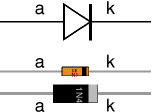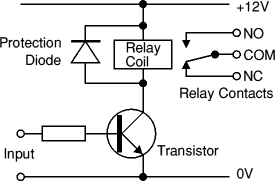Diodes
Diode is a semiconductor device. Diode play an important role in electronics circuits. They are used mainly in uncontrolled rectifiers to convert AC to fixed DC voltages and as freewheeling diodes to provide a path for the current flow in inductive loads.
Construction
Diodes can be made of either of two semiconductor materials, silicon and germanium. Power diodes are usually constructed using silicon. Silicon diodes can operate at higher current and at higher junction temperatures, and they have greater reverse resistance.
The structure of a semiconductor diode and its symbol are shown figure below. The diode has two terminals an anode A terminal (P junction) and cathode K terminal (N junction). When the anode voltage is more positive than the cathode, the diode is said to be forward-biased, and it conducts current readily with a relatively low voltage drop. When the cathode voltage is more positive than the anode, the diode is said to be reverse-biased, and it blocks the current flow. The arrow on the diode symbol shows the direction of conventional current flow when the diode conducts.

Diodes Function
Diodes allow electricity to flow in only one direction. The arrow of the circuit symbol shows the direction in which the current can flow. Diodes are the electrical version of a valve and early diodes were actually called valves.
Forward Voltage Drop
Electricity uses up a little energy pushing its way through the diode, rather like a person pushing through a door with a spring. This means that there is a small voltage across a conducting diode, it is called the forward voltage drop and is about 0.7V for all normal diodes which are made from silicon. The forward voltage drop of a diode is almost constant whatever the current passing through the diode so they have a very steep characteristic (current-voltage graph).
Reverse Voltage
When a reverse voltage is applied a perfect diode does not conduct, but all real diodes leak a very tiny current of a few µA or less. This can be ignored in most circuits because it will be very much smaller than the current flowing in the forward direction. However, all diodes have a maximum reverse voltage (usually 50V or more) and if this is exceeded the diode will fail and pass a large current in the reverse direction, this is called breakdown.
Ordinary diodes can be split into two types: Signal diodes which pass small currents of 100mA or less and Rectifier diodes which can pass large currents. In addition there are LEDs (which have their own page) and Zener diodes (at the bottom of this page).
Connecting and soldering

Diodes must be connected the correct way round, the diagram may be labeled a or + for anode and k or - for cathode (yes, it really is k, not c, for cathode!). The cathode is marked by a line painted on the body. Diodes are labeled with their code in small print; you may need a magnifying glass to read this on small signal diodes!
Small signal diodes can be damaged by heat when soldering, but the risk is small unless you are using a germanium diode (codes beginning OA...) in which case you should use a heat sink clipped to the lead between the joint and the diode body. A standard crocodile clip can be used as a heat sink.
Rectifier diodes are quite robust and no special precautions are needed for soldering them.
Testing diodes
You can use a multimeter or a simple tester (battery, resistor and LED) to check that a diode conducts in one direction but not the other. A lamp may be used to test a rectifier diode, but do NOT use a lamp to test a signal diode because the large current passed by the lamp will destroy the diode!
Signal diodes (small current)
Signal diodes are used to process information (electrical signals) in circuits, so they are only required to pass small currents of up to 100mA.
General purpose signal diodes such as the 1N4148 are made from silicon and have a forward voltage drop of 0.7V.
Germanium diodes such as the OA90 have a lower forward voltage drop of 0.2V and this makes them suitable to use in radio circuits as detectors which extract the audio signal from the weak radio signal.
For general use, where the size of the forward voltage drop is less important, silicon diodes are better because they are less easily damaged by heat when soldering, they have a lower resistance when conducting, and they have very low leakage currents when a reverse voltage is applied.
Protection diodes for relays
| Diode | Maximum Current | Maximum Reverse Voltage |
|---|---|---|
| 1N4001 | 1A | 50V |
| 1N4002 | 1A | 100V |
| 1N4007 | 1A | 1000V |
| 1N5401 | 3A | 100V |
| 1N5408 | 3A | 1000V |
Signal diodes are also used with relays to protect transistors and integrated circuits from the brief high voltage produced when the relay coil is switched off. The diagram shows how a protection diode is connected across the relay coil, note that the diode is connected 'backwards' so that it will normally NOT conduct. Conduction only occurs when the relay coil is switched off, at this moment current tries to continue flowing through the coil and it is harmlessly diverted through the diode. Without the diode no current could flow and the coil would produce a damaging high voltage 'spike' in its attempt to keep the current flowing.
Rectifier diodes (large current)
Rectifier diodes are used in power supplies to convert alternating current (AC) to direct current (DC), a process called rectification. They are also used elsewhere in circuits where a large current must pass through the diode.
All rectifier diodes are made from silicon and therefore have a forward voltage drop of 0.7V. The table shows maximum current and maximum reverse voltage for some popular rectifier diodes. The 1N4001 is suitable for most low voltage circuits with a current of less than 1A.
